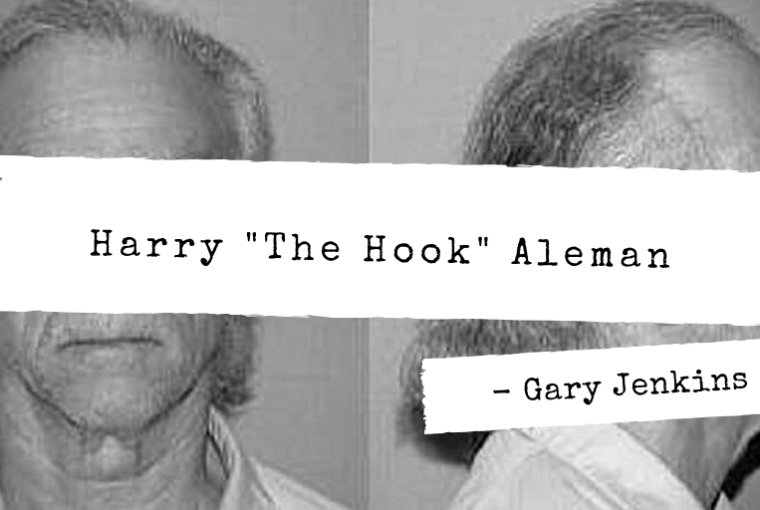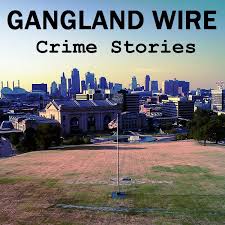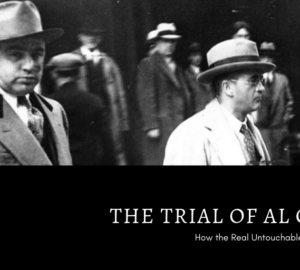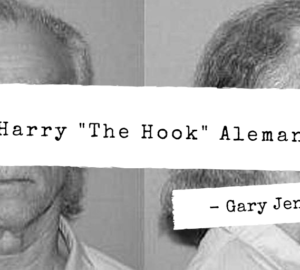This is the 4th and final installment about the life and times of Chicago’s most feared hit man Harry “The Hook” Aleman.
Harry had been raised in the mob life by a spouse abuser and violent criminal. He turned to a father figure in his uncle, Joe Ferriola, a member of the Chicago Outfit. Even though Harry was indoctrinated in a criminal’s life, he had this extra intelligence that many professional criminals never exhibit. He graduated from high school and a good art school in Chicago. He was a dedicated family man who loved his 4 step children. On the other hand, Aleman had shown himself to be a skilled leader of a burglary and home invasion robbery crew. When Joe Ferriola decided to organize all Chicago gamblers like Al Capone organized all the speakeasies and bootleggers during prohibition, Aleman was the point man in finding and recruiting sports bookies off-track race gamblers to muscle in on ½ their business and extract what they called the street tax. He was the Outfit’s most efficient hit man and most effective intimidator. He liked the idea of hitting his victims in a public place. One murder he did will come back to haunt him, he chose the wrong driver and the wrong place to kill a Teamster named Billy Logan in front of his house. His getaway driver, Lou Almeida, got into his own trouble and made a deal to become a government witness. Bobby Lowe, a neighbor, witnessed this hit and identified Harry as the killer. This case will become famous in legal circles around the nation. Cook county prosecutors would indict and try Aleman for the Logan murder and be stunned by an inconceivable not guilty verdict by Judge Frank Wilson. In this installment we will learn about a new witness who reveals exactly why the judge arrived at this verdict.
This is the first time a criminal defendant will be tried twice for the exact same crime.
During the 1980s, The FBI, the IRS and a Cook County prosecutor named Terence Hake conducted Operation Greylord, a 3 year long undercover investigation to expose corruption and bribery in the Cook County court system. They exposed many corrupt clerks, judges and police officers in the system. In 1986, 3 years after Operation Greylord finished, a Cook County criminal defense attorney named Robert J. Cooley walked into the FBI office and offered to work. He knew where a lot more bodies were buried. He had seen the success of Operation Greylord and felt guilty about his past use of bribery for the Outfit but felt powerless. The final straw was when he was forced by his mob contacts to bribe a judge to exonerate an Outfit connected defendant who had severely beaten a Chicago police woman. Robert “Bob” Cooley had started his career as a young Chicago cop before law school and came from a long line of Chicago cops who were not corrupt. After several years in this corrupt system, Bob Cooley had seen enough and claims he wants it stopped. Bob Cooley may have had an ulterior motive, he was a degenerate sports gambler and was often in debt to Outfit bookies. Cooley was the Outfit’s go-to guy to solicit and pass along bribes to Cook County court officials and Chicago cops. He was a close friend and confident to Butch Petrocelli and many other individual Outfit members. Cooley’s main contact in the outfit was Marco D`Amico, who was in the Elmwood Park crew and ran a major bookmaking organization and juice loan business. D’Amico once intimidated a bookie to forgive a $50,000 gambling debt owed by the lawyer Cooley. Of course, no good deed goes unpunished and later Cooley will wear a wire on him to help his new FBI friends set up D’Amico on a robbery, gambling and extortion conspiracy which became the predicate acts for a racketeering charge.
During his debriefing, Robert Cooley told numerous stories of extensive corruption, despite the recent Operation Greylord indictments. He named many court officials, including judges, and cops who escaped Greylord and supposedly incorruptible. The FBI realized they must mount another long-term undercover investigation and they code-named this Operation Gambat, short for Gambling Attorney. Because Cooley had also been acting as a bookmaker and held high stakes poker games in his office, he revealed a lot of facts about Outfit relationships and activities.
Cooley told FBI agents that back in 1977 Outfit member and Cook County fixer Pat Marcy asked him for a meeting at Marcy’s regular table at a downtown restaurant called Counselors Row. Marcy asked Cooley to offer a bribe to whatever judge would hear the murder case against Harry Aleman trial for killing Teamster member Billy Logan. It was at this table that Pat Marcy told him that Aleman case must be fixed. Cooley said he told Marcy this was very sensitive and must be handled delicately because Aleman drew a lot of attention. He explained that the Aleman case must get assigned to a corruptible judge to even have a chance. Marcy already knew that Aleman had asked for a bench trial, so they only had to bribe a judge. Cooley remined Marcy that even if they found the right judge, Aleman’s defense attorney must present some disputing fact or facts to enable the judge to rule that the state had not proven its case beyond a reasonable doubt.
Cooley was a close friend to Cook County Judge Frank Wilson and often visited him in his chambers. That relationship allowed Cooley to know Wilson had heavy expenses from paying for a country club membership and his children’s private school tuition. Wilson had a reputation as a “hard-nosed, state-oriented judge who had no empathy” for criminals. Cooley approached Wilson at a downtown bar and mentioned that he had been approached to handle a big murder case. Wilson spontaneously replied, “The Aleman Case?” In the long tradition of unspoken communication in this corrupt world, Judge Wilson knew that Cooley was the man who offered bribes and when he appeared unfazed by this talk about Cooley handling the Aleman case, Cooley surmised he was open to bribery discussions. From that interchange, Bob Cooley returned to Marcy and said he may have a judge. When Cooley gave Marcy the name, he replied that Aleman’s lawyer had already requested that Wilson not be a judge on this case. Marcy then indicated not to worry about that if Wilson will play ball for $10,000.00. Cooley will never know how this happened, but his judge Frank Wilson got the case. The first court assignment for the Aleman case was to Judge James Bailey. Aleman’s lawyer, Tom Maloney filed a motion for substitution of judge, naming Bailey and adding Judge Frank Wilson as unacceptable because they were allegedly biased. The Chief Judge reassigned this case to a judge named Fred G. Suria Jr, but Aleman’s lawyers also objected to Suria contending he was biased. However, this appointment must stand because the layer filed this motion beyond the deadline. Then unexpectedly, Suria recused himself because the motion contained information that could have been the basis for a reversal. Suria called Chief Judge Richard Fitzgerald to get the case reassigned and he assigned Judge Frank Wilson even though Wilson had already been rejected by Aleman’s lawyers as unfair.
After that assignment was known, Cooley met with Judge Frank Wilson one more time in the bathroom of a downtown bar. He told him that he had $10,000 to handle the case. Wilson nodded agreement and Cooley warned, “If you take this money, you must do what you have bargained to do because these are serious and dangerous people.” Wilson asked what the evidence was, and Cooley said, “They have an Outfit guy, Louis Almeida, who helped commit this murder by driving Harry Aleman to and away from the murder scene, but this guy has many problems of his own and will be easily discredited. Cooley told the judge a neighbor was an eyewitness, but this guy had waited several days before he admitted he was a witness. For that reason alone, this witness could be easily discredited. He said this was the only evidence and that Aleman would provide alibi witnesses.
Wilson promised, “If you get this case into my court, we have a deal.” Cooley gave Judge Wilson $2500.00 cash of his own money to cement this agreement. He promised the remaining $7500 after an acquittal. Wilson demanded that Aleman’s first lawyer, Tom Maloney, withdraw from the case because he had been the one who rejected Judge Wilson early in the process. This lawyer had already asked for a bench trial and Cooley knew that it looked bad if the lawyer who asks for a bench trial, rejects a certain judge and then accepts that same judge for the trial.
Cooley returns to Pat Marcy and assures him he has the judge in his pocket, but Aleman must get a new lawyer. Pat Marcy agrees and states he will tell Aleman to make this happen. Aleman fires Tom Maloney and he files a withdrawal. Aleman hires a new lawyer named Frank Whalen he files an entry of appearance and becomes the new lawyer of record. Whalen meets with Cooley and he is assured that Cooley has Judge Frank Wilson in his pocket.
A few weeks later, Cooley gets a call from Aleman asking for a meeting. Upon arrival, Aleman tells Cooley that his brother has found a neighborhood girl who will take $10,000.00 to go into court and testify she was outside the night of the murder and that it was not Harry Aleman who shot Billy Logan.
Two days into the trial, Cooley receives a panicked call from Judge Wilson. He complains that Bob Lowe is a very convincing witness and the new lawyer was doing a crappy job of cross examination. He also is angry because it had come out in a lawyer’s meeting in the judge’s chambers that the girl had been paid $10,000.00 and the judge had to dismiss her as a witness. He stated to Cooley, “This is what you give me? They are fucking burying me. I am going to lose my judgeship over this.” Cooley calms him down and the judge asks for more money. Cooley believes the judge’s real problem was that they paid this girl $10,000.00 to be a witness while they paid him $10,000.00 to guarantee a dismissal. Cooley He goes back to Pat Marcy asking for more money and Marcy reminds him who they are dealing with and refuses to give out any more money.
Cooley reported that the day the verdict was to be delivered, he was frightened out of his wits that Judge Wilson would not hold up his end of the bargain and deliver a guilty verdict. He packed his clothes into his car and was ready to leave town. The judge grants a not-guilty verdict and a very happy Harry Aleman exits the courtroom. Robert Cooley meets Pat Marcy at Counsellors Row and he hands Cooley two envelopes. One with the remaining $7500.00 for the Judge and one with $3000.00 for Cooley. Cooley had already paid $2500.00 out of his own pocket so after he is reimbursed that, the Outfit pays him $500.00 for this huge risk he took for Aleman.
Here is a link to some news footage of Aleman leaving the courtroom and greeting his family and making a statement.
At the outset of operation Gambat Cooley reported to the FBI that Marcy and another outfit fixer named John D’Arco always sat at the same table in Counsellors Row to meet and discuss court cases, gambling business and other Outfit business. The FBI will place a hidden mike here only to have it found by a bus boy.
Just before the government announced the indictments out of Operation Gambet, Robert Cooley visited now retired Judge Frank Wilson at his Arizona retirement village. He tried to get Wilson on tape to collaborate this bribe. He was unable, but Wilson saw the handwriting on the wall and committed suicide shortly after the visit.
In 1997, because Robert Cooley is willing to testify about the bribe given to Judge Frank Wilson, Harry Aleman was tried a second time for the Logan murder. Bob Lowe and Louis Almeida are still alive and willing to testify. Almeida had no choice because he was in witness protection and had agreed as part of his deal to testify in this case. Bob Lowe voluntarily testified, and he had to go through the same intimidation as before. A man visited his work looking for him and told him he knew the names of his wife and daughter and where they lived. Aleman was in jail without bond and he was overheard to claim that the witnesses would be “taken care of.” The first pretrial motion was a claim of double jeopardy. The prosecution replied with an argument that double jeopardy could not apply because of the bribe. In other words, because of the bribe, Aleman was never in jeopardy of being convicted. They argued the first case was built on fraud, so it was null-and-void and the court should treat it as if it never happened. The prosecution argument won and September 22, 1997, 25 years after Harry Aleman killed Billy Logan, the trial began. This was the first time in U.S. history that a citizen acquitted of murder would be tried a second time for the same crime.
The second trial had its own drama. One day into the trial, the judge declared a mistrial when a juror, described only as a suburban woman who works as a flight attendant and nurse, called the prosecutor and said she feared for her life and would like to be excused from the court. Below is an exact quote made by that juror. After you read her quote, you will understand why she was dismissed. In all trials, the court will have at least 2 persons called alternate jurors. They will sit though the entire trial as if they are a voting juror. If anything like this happens, they move in and become another member of the voting jury.
This dismissed juror said, “Well, to be honest, I was just worried about this case and where it’s going and what could happen to me as well as, you know, family members, I just wanted to know if there was anything that I could do to take myself out of it. When they say there are many witnesses who are not here to be able to testify these days, I mean, I don’t know if that’s all because of natural causes.” She went on to say, “Just basically, you know, I hope we’re around after this. We’ll exchange Christmas cards and hopefully we are all around at Christmastime. Just things like that. We just kind of lightheartedly, you know, talk about it.”
In the second trial with a new jury, Aleman’s lawyers cleverly muddied the waters by suggesting that noted mob killer William “Butch” Petrocelli had gunned down Billy Logan in 1972. To solidify the point, the defense called Logan’s ex-wife, Phyllis Napoles, who told the jury that six months before he was murdered, Logan was involved in a fist fight with Petrocelli during which Petrocelli threatened to kill Logan. Billy Logan’s ex-wife continued to discredit her deceased husband by testifying, “It was a very sad marriage, He (Logan) drank a lot. He was abusive to me and the children.” After divorcing Logan in 1967, she said she became “intimate” with Petrocelli and that Petrocelli asked her to marry him. “I had a great deal of respect for his dark side” She said about Petrocelli, “He had a very violent nature in him.” Napoles testified, I remember one night my ex-husband (Logan) had been drinking heavily and he started to kick in the door when “Butchie” Petrocelli was at the house.” She claimed that Betrocelli asked Logan to leave and when he refused, they went to the alley and fought. Petrocelli, a longtime friend of Aleman’s, couldn’t argue the point. He disappeared on December 30, 1980. His body was found in March of 1981 in the trunk of his car parked on a Southwest Chicago street. The reasons given for Petrocelli’s killing vary. Some in law enforcement believed he was murdered for stealing mob money, some suspect he was trying to take over gambling operations that belonged to someone else, and still others suspect Aleman ordered his death for reasons unknown.
The prosecution totally discredited Logan’s ex-wife during cross-examination, especially when it came out that one of her children by a prior marriage had visited Aleman in prison.
Aleman’s lawyers complained that much of the evidence from the 1977 trial was missing including the defense trial file that contained shotgun wadding and pellets recovered from Billy Logan’s body as was Logan’s bloodstained clothing and diagrams and photo displays used in the first trial. Worse yet the defense complained that many alibi witnesses for Aleman and people who could give other exculpatory testimony beneficial to Aleman were dead.
The judge had barred any references to organized crime and as a result, Aleman background as a noted Outfit killer, suspected in 15 to 20 mob murders, was unknown by the jury, as was Petrocelli’s criminal history. The judge refused to allow testimony or other evidence about Petrocelli’s death because his face had been burned beyond recognition and he had been stabbed twice in the throat. Aleman’s lawyers didn’t object to introduction of Cooley’s testimony about the bribe to Judge Wilson even though Wilson had committed suicide in 1990.
Bobby Lowe testified again that he saw a car with its engine idling, then he saw a shotgun protruding from a back-seat window. He heard gunfire. He saw Logan fall and then a man exits the passenger door carrying a pistol and proceeds to fire the killing rounds into Lowe’s prostrate body. Lowe said he stared into the killer’s dead coal black eyes for what seemed like an eternity before he panicked and ran back to his house. He dramatically pointed out defendant Harry Aleman as that killer.
On October 1, 1997, twenty years after his acquittal in the same case, a jury found Harry Aleman guilty of murdering William “Billy” Logan. The judge sentenced him to 100-300 years in jail. Apparently, the jury did not buy into the theory that William Petrocelli killed Billy Logan.
Aleman later complained about his 100- to 300-year prison term saying,
“Serial killers get that. I caused no problems for anybody, and I’m no threat to anybody.”
Harry Aleman will die in prison at the age 71 on May 15, 2010 . He was at a state prison called the Hill Correctional Center in Galesburg, Ill.
- The Trial of Al Capone – How the Real Untouchables Brought Him Down - March 24, 2019
- Harry “The Hook” Aleman: Chicago Outfit Enforcer (Part 4) - January 17, 2019
- Harry “The Hook” Aleman: Chicago Outfit Enforcer (Part 3) - January 10, 2019






 Part 1
Part 1
